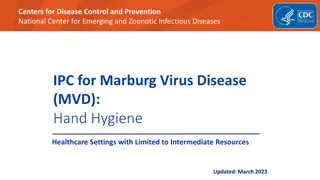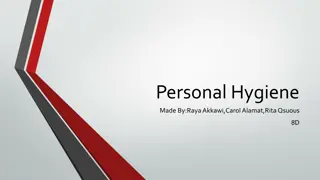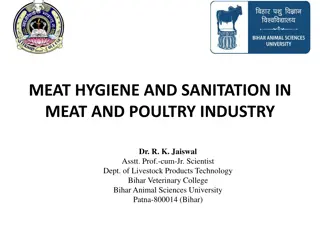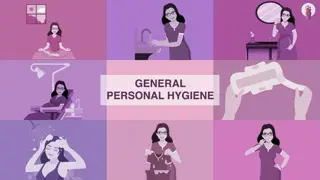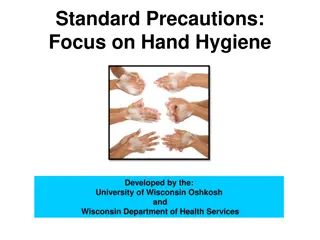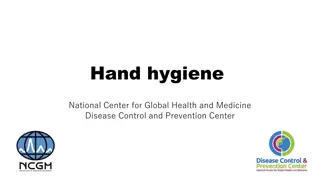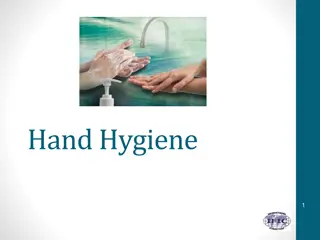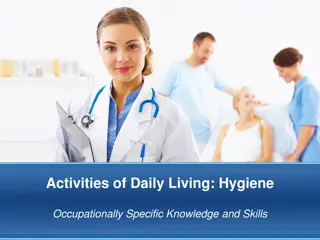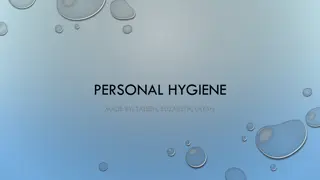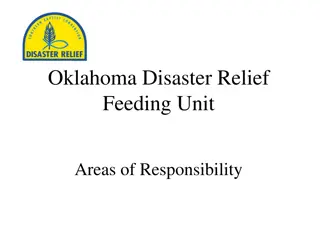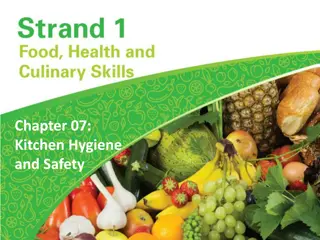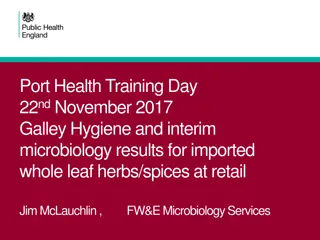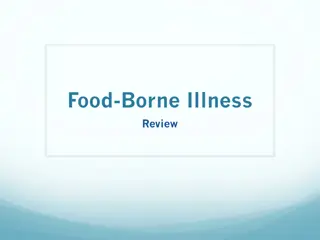Comprehensive Guide to Personal Hygiene in Food Handling
Understanding the importance of personal hygiene in food handling operations is crucial for maintaining a safe environment and preventing contamination. This guide explores the key practices and procedures involved in maintaining high standards of hygiene in food preparation, storage, and handling areas. It covers topics such as hand washing, cleanliness of work surfaces, storage procedures, and control measures to ensure safe food practices. By implementing these guidelines, food handlers can contribute to the prevention of foodborne illnesses and promote overall health and safety.
Download Presentation

Please find below an Image/Link to download the presentation.
The content on the website is provided AS IS for your information and personal use only. It may not be sold, licensed, or shared on other websites without obtaining consent from the author. Download presentation by click this link. If you encounter any issues during the download, it is possible that the publisher has removed the file from their server.
E N D
Presentation Transcript
Module 1 Hygiene HYGIENE Hygiene is defined as the many practices that help people be and stay healthy. It also deals with the promotion and preservation of health. www.futuremanagers.com
Module 1 Hygiene (continued) PERSONAL HYGIENE DURING THE HANDLING OF FOOD Personal hygiene must play an essential part in the day-to-day running of any safe food operation. To be effective, personal hygiene should be a part of everyday habits as soon as food handlers start working in the industry. Good personal hygiene includes thorough and regular washing one s body (especially hands), washing one s hair, brushing and flossing teeth, and caring for feet. www.futuremanagers.com
Module 1 Hygiene (continued) FACTORS INFLUENCING HYGIENE The condition of the area - all areas surrounding the facility should be clean. Construction and condition of the building the premises should not permit entry for or harbour pests. Water supply pipes and general plumbing must be well insulated and boxed in to prevent pests from entering the facility. Handling of food and other stock food preparation areas should be kept clean, and food handlers maintain good standards of personal hygiene at all times. www.futuremanagers.com
Module 1 Hygiene (continued) HYGIENE PROCEDURES IN THE WORK AREAS Washing hands and disinfecting all work surfaces is the starting point Clean as you go. Avoid over handling of food, Mop up any spills immediately to prevent slipping. Keep the waste bin closed at all times and discard all refuse daily. Throw away broken and chipped crockery as cracks are ideal for germs to harbour in. Clean all surfaces, including floors, after each shift. www.futuremanagers.com
Module 1 Hygiene (continued) HYGIENE PROCEDURES IN STORAGE AREAS All non-perishable food items are stored in the dry store, and the dry store has specific environmental conditions which should be adhered to. Store meats and other cold foods in cool storage areas before moving them to refrigerators. Make sure freezers are regularly cleaned. www.futuremanagers.com
Module 1 Hygiene (continued) CONTROL MEASURES Receiving: Ingredients should be bought from reputable suppliers. Inspecting: Items should be checked to see whether the quality and quantity is good. Handling: Those handling the food should practice good personal hygiene. Storing: Items should be stored for only as long are they are good and should be allowed to ripen if needs be at room temperature. Leftovers: Reheating should ne avoided especially not more than once. www.futuremanagers.com
Module 1 Hygiene (continued) PEST CONTROL Pests are defined to include, but are not limited to, birds, rodents, insects and arachnids (spiders). To practice safe pest control: Food premises are to be kept clean and maintained in good repair and condition. Windows are to be fitted with insect-proof screens which can be removed for cleaning. Adequate procedures are to be in place to control pests. Reduce the supply of food, access routes and shelter for pests. www.futuremanagers.com
Module 1 Hygiene (continued) COMPILING A CLEANING SCHEDULE When setting up a cleaning schedule, the following steps can be used as a guideline: 1. Identify what needs to be cleaned. 2. Identify how often it needs to be cleaned. 3. Identify who will be cleaning. 4. Identify what chemicals or cleaning agents will be used to complete the task. 5. Identify what precautions are needed to protect the person carrying out the task. 6. Monitor the schedule. 7. Revise the adequacy of the cleaning schedule. www.futuremanagers.com
Module 2 Health TUBERCULOSIS IN THE WORKPLACE Tuberculosis (TB) is a chronic infectious disease which can be spread in the food service facility. TB is spread mainly through the air. Since TB is not transmitted via food, the risk of TB transmission in the food or restaurant industry is no greater than in any other general work settings. www.futuremanagers.com
Module 2 Health (continued) HIV/AIDS IN THE WORKPLACE Acquired immune deficiency syndrome or acquired immunodeficiency syndrome (AIDS) is a disease of the human immune system caused by the human immunodeficiency virus (HIV). Ways to prevent the spread of HIV/AIDS is to educate citizens about the viruses, to avoid contact with infected blood and to practice safe sex. www.futuremanagers.com
Module 2 Health (continued) THE INFLUENCE OF TOXIC AGENTS ON THE BODY Drugs can be divided into three main types, according to how they affect the central nervous system. The three groups are: depressants, sedatives and hypnotics; stimulants, and hallucinogenic drugs. www.futuremanagers.com
Module 3 Microbiology GENERAL CHARACTERISTICS OF MICRO-ORGANISMS The word micro-organism is a general term used to describe a very small organism. Micro-organisms can be used to: Ferment useful chemicals; Produce certain food stuffs; Destroy wastes; Prevent disease; and Produce antibiotics used to treat disease. www.futuremanagers.com
Module 3 Microbiology (continued) TYPES OF MICRO-ORGANISMS Protozoa; Fungi, yeast and mould; Bacteria. www.futuremanagers.com
Module 3 Microbiology (continued) FACTORS THAT INFLUENCE THE GROWTH OF MICRO-ORGANISMS Time; Availability of food; Moisture; Temperature; Availability of oxygen; pH surrounding bacteria; and Competition. www.futuremanagers.com
Module 3 Microbiology (continued) DESTRUCTION OF MICRO-ORGANISMS General factors that lead to the destruction of micro-organisms: Involves physical heat radiation or microwaves and/ or chemical agents. None of these can guarantee complete eradication. Susceptibility to the effects of physical and chemical agents depends upon the type of microorganism and at what stage in the micro-organism s life cycle they are exposed to the agent. www.futuremanagers.com
Module 3 Microbiology (continued) CAUSES OF FOOD POISONING AND DISEASES SPREAD BY FOOD Food poisoning may be caused by a variety of sources including: Bacteria; Viruses; Chemicals; Metals; and Poisonous plants/animals. www.futuremanagers.com
Module 3 Microbiology (continued) MEDIUM FOR FOOD POISONING The chain: To grow, bacteria need warmth, moisture, food and time; these four elements are known as the food-poisoning chain . www.futuremanagers.com
Module 4 Cleaning and disinfecting CLEANING AND DISINFECTING Cleaning is the complete removal of food soil using an appropriate detergent or suitable chemicals under recommended conditions. A disinfectant is a chemical agent which is used to destroy disease-causing bacteria, microorganisms or pathogens, excluding spores and some viruses. www.futuremanagers.com
Module 4 Cleaning and disinfecting (continued) OBJECTIVES OF CLEANING The main reason for cleaning is to promote general health and safety in the food service facility by preventing cross-contamination. This is achieved by maintaining a cleaning programme. www.futuremanagers.com
Module 4 Cleaning and disinfecting (continued) WHEN A SURFACE IS CLEAN A surface can be seen as clean when: It appears clean, under sufficient lighting. It feels clean, and no greasy residues are present. If the surface were to be microbiologically tested, the result would be negative. The results of the test carried out should show that the amount and type of bacteria present would not cause serious contamination of food or cause any harm to people consuming the food. www.futuremanagers.com
Module 4 Cleaning and disinfecting (continued) MICROBIOLOGICAL TESTS FOR CLEAN SURFACES Three tests can be carried out to test for microbiological growth: Swabbing over a specific area; Rinse samples; and Direct recovery onto growth medium (agar). www.futuremanagers.com
Module 4 Cleaning and disinfecting (continued) CLEANING ROUTINE When setting up a cleaning routine, one must keep 5 very important factors in mind. They are: Time; Temperature; Mechanical action; Chemical action; and Procedure. www.futuremanagers.com
Module 4 Cleaning and disinfecting (continued) USE OF WATER FOR CLEANING In the food service industry, all cleaning procedures make use of water. This can be through: Boiling water; Hot/warm water; Steam cleaning; Autoclaving; and Rinsing of surfacing. www.futuremanagers.com
Module 4 Cleaning and disinfecting (continued) DISINFECTANTS An ideal disinfectant: Should offer microbiological sterilisation without being of harm to the user. It should not damage or corrode the area or surface to which it is applied. It should be cost effective. The method of application should be user friendly and require little skill. www.futuremanagers.com
Module 4 Cleaning and disinfecting (continued) GENERAL CLEANING Cleaning generally happens as you go along. Cleaning should always be done as time and cost effectively as possible, without neglecting the quality of work done. Cleaning procedures should be carried out at times when they will least affect the productivity of the staff. www.futuremanagers.com
Module 5 Safety CAUSES OF ACCIDENTS IN THE WORKPLACE Accidents in the workplace are due to: Poor workplace design; Hazardous tasks being performed in the workplace; Incorrect installation, storage, and use of equipment in the workplace; People being exposed to hazardous substances or processes; and The lack of knowledge in how to use certain equipment. www.futuremanagers.com
Module 5 Safety (continued) SAFETY MEASURES FOR THE USE OF APPARATUS AND MACHINERY In the food service industry, safe job procedures are necessary. When handling kitchen equipment, always be aware of what you are doing. Ask your supervisor if you are not sure how to handle a piece of equipment. Check on the equipment to make sure it is turned off before plugging it in. Make sure all safety guards are in place. If they are missing notify your supervisor immediately. Wear personal protective equipment provided by your employer. www.futuremanagers.com
Module 5 Safety (continued) RECENT HEALTH AND SAFETY LEGISLATION Occupational Health and Safety Act was implemented to provide health and safety for persons at work. Employers are legally obligated to ensure the health and safety of the employee while employees are obligated to take responsibility of their own health and safety. www.futuremanagers.com
Module 5 Safety (continued) EMERGENCY PLAN An emergency action plan (EAP) is a written document which helps to facilitate and organise employer and employee actions during workplace emergencies. Emergencies that may occur include fires, bomb threats, large-scale natural disasters, hostile acts and chemical spills. When compiling an emergency evacuation plan, you must include evacuation routes, emergency phone numbers and emergency reporting. www.futuremanagers.com



